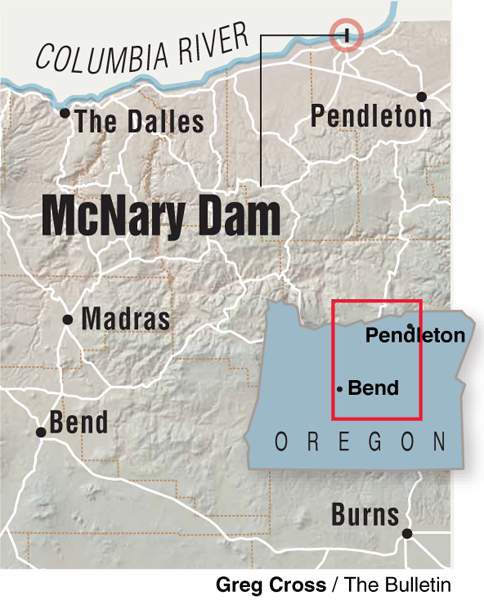McNary Dam
Published 5:00 am Friday, October 31, 2008

- McNary Dam
McNary Lock and Dam on the Columbia River is a testament to eager-beaver technology and large-scale engineering prowess. The raw facts are impressive: 4.085 million visitors each year, $137 million in local revenue, $265.5 million in hydropower generated.
The Army Corps of Engineers is good with numbers. It’s the largest federal provider of outdoor recreation in the nation, according to my tour guide, Pasquale Anolfo, hosting 385 million visitors per year. More impressive to me is that the Corps builds these humongous edifices that harness the mighty Columbia; at any time McNary’s 14 generators can produce 1,120,000 kilowatts of electricity and provide an average of 6.5 billion kilowatt-hours each year for us Northwesterners.
Of course, when the Corps erected McNary in 1954, it had to figure out how people and salmon could get past this most imposing of barriers.
The locks allow more than 7 million tons of cargo past the dam each year upriver to the Snake River and Lewiston, Idaho.
It’s a bit more complicated for the anadromous fish — steelhead, salmon, lamprey and shad — that live in the Pacific Ocean and migrate upriver to spawn.
Heading upriver, they have to negotiate a multi-rung fish ladder to get up and over the dam. Going downriver, the juvenile fish are stopped by screens at the generator openings so they don’t get shredded by the turbines. From there, the 8- to 12-inch fish are herded into the juvenile bypass facility. Then, the juvenile fish are either returned to the river below the dam or loaded into barges or trucks for release downriver below Bonneville Dam.
The downriver migration is fraught with danger and loaded with unseen drama for the small fish, who face peril at every turn. Viewing windows on the Oregon side of McNary Dam allow visitors to watch returning salmon, steelhead and shad summit the ladder and shoot by to the upriver side.
We set up a tour a few days before we arrived, and Anolfo, a U.S. Army Corps of Engineers representative, was kind enough to escort my son Daniel and I across the dam to the Washington Fish Viewing Room.
I’ve got a thing about fish.
I like to catch them and I like to watch them. The viewing windows give us a snapshot of these magnificent fish, some 50 pounds and more, in their journey to natal waters. The salmon, especially the big chinook, tend to wait at the top of the ladder, then jet by the window as if they don’t like the attention. A technician, sitting at a desk in front of the window, identifies each fish and enters it into a computerized log.
In 15 minutes, we saw upward of 100 shads and more than a dozen chinook and sockeye salmon. Late June and July through fall is a good time to see fish passing through.
There’s also a three-story Pacific Salmon Visitor Information Center at McNary where you can learn all about the dam and these remarkable fish.
If you’re itching to stretch your legs after the drive from Central Oregon, there’s a 4.5-mile trail system below the dam with fishing ponds and above par bird watching along its length. Above the dam on the Oregon side, McNary Beach and Warehouse Beach offer swimming and day-use facilities. There’s also camping and picnicking at Sand Station.
From Bend, drive north on U.S. Highway 97 through Madras and Shaniko and on to Biggs. From Biggs, take Interstate 84 east, then Interstate 82 north to Umatilla and the dam. It’s about a four-hour drive. Free.
Contact: U.S. Army Corps of Engineers, 541-922-2268.
— Jim Witty






